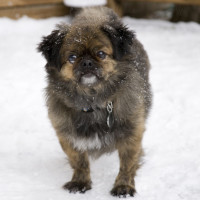Appearance of the Pugzu
|
| Some would say the Pugzu has a face only a mother would love, and it's true that they have a rather unusual look. With their rounded black eyes, domed skull and short muzzle, they look a lot like an Ewok from Star Wars. They have triangular ears that droop and are often set high on the head and wide apart. Their bodies are long and sturdy, making them more robust and powerful than they first appear. They have short, stocky limbs that can bend at an angle. Some will have the Pug's curved tail along their back, but not all. The Pugzu is a small dog measuring between 20 and 30 centimeters and weighing between 4.5 and 10 kilos. The Pugzu's coat is relatively short and should not shed much. Some puppies will shed more after their Pug parent and have shorter coats than others. A variety of coat colors are possible, including fawn, black, red, white and cream. Although solid colors are common, it's not unusual to see a Pug with two colors, such as fawn and black. |
Temperament of the Pugzu
|
| It's never easy to predict the temperament of a crossbreed, but the Pugzu tends to have a fairly uniform character. An affectionate, big-hearted dog, the Pugzu needs companionship and relies on its family for support and comfort. They will show great affection and will always be loyal to those they love. They will form good relationships with the whole family, although they may choose a particular person to devote themselves to. Great fun to have around children, the Pugzu knows how to be gentle and has a lot of patience. They're happiest at play and will keep the little ones entertained for hours. Pugzu are so tolerant of people and are poor watchdogs. Even if they give one or two lively greetings, they'll soon be asking the newcomer to make friends. One of the Pugzu's main problems is that they are prone to separation anxiety and can be very difficult to keep alone. They become anxious if left alone for long periods. They would therefore not be suited to a household that is often left empty. Occasional indoor training can help, and there should be plenty to keep them entertained when no one else is around. |
Needs and activities of the Pugzu
|
| The Pugzu is relatively active, given its small size. Your gentle Pugzu will need at least 30 minutes of activity a day, which may include a walk outdoors, a stroll in the dog park or fenced yard and indoor play. An apartment will suffice for the Pugzu depending on its small size, assuming it gets the activity it needs. When you're outside in hot weather, you want to make sure your Pugzu doesn't get overexcited, as this can cause him to overheat. It's likely that your Pugzu will prefer to lie still at times, however, it's important that he gets the physical activity he needs. |
Maintenance of the Pugzu
|
| The amount of shedding you can expect from a Pugzu will vary, just as it can with the Pug's parent breed, which can shed little to frequently. Pugzu's long coats will need daily cleaning, as his coat can tangle very easily. It's a good idea to take him to the groomer for regular trimming. The Pugzu should only be bathed when necessary, and with a dog shampoo to avoid damaging its natural oils. When Pugzus have longer hair, it may get into their eyes and need to be clipped or tied back. Pugzus that inherit shorter coats will require less maintenance, but whatever the length of his coat, you'll need to brush his teeth regularly, check his ears every week and trim his nails if necessary. |









 English (United Kingdom)
English (United Kingdom)